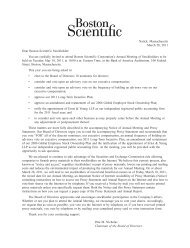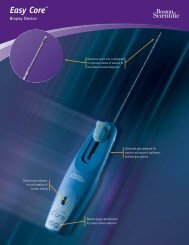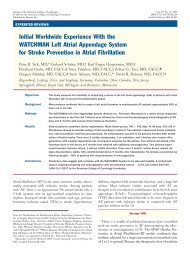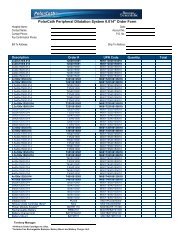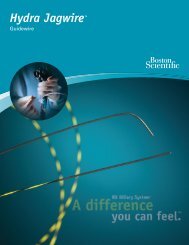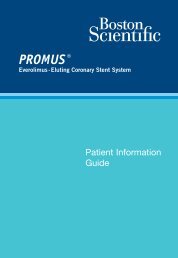PROMUS Element⢠Plus - Boston Scientific
PROMUS Element⢠Plus - Boston Scientific
PROMUS Element⢠Plus - Boston Scientific
Create successful ePaper yourself
Turn your PDF publications into a flip-book with our unique Google optimized e-Paper software.
THE fOiL POUCH iS nOT a STEriLE barriEr.<br />
Do not store devices where they are directly exposed to<br />
organic solvents or ionizing radiation.<br />
The foil pouch contains Argon (Ar) as a storage medium.<br />
DiSPOSaL inSTrUCTiOnS: After use, dispose of product and<br />
packaging in accordance with hospital, administrative and/or<br />
local government policy.<br />
14 OPEraTiOnaL inSTrUCTiOnS:<br />
14.1 inspection Prior to Use<br />
Check foil pouch for ‘‘Use By’’ date. Do not use the product<br />
after the ‘‘Use By’’ date. Carefully inspect the foil pouch and<br />
the sterile package before opening. If the integrity of the foil<br />
pouch or the sterile package has been compromised prior<br />
to the product ‘‘Use By’’ date (e.g., damage of the package),<br />
contact your local <strong>Boston</strong> <strong>Scientific</strong> representative for return<br />
information. Do not use if any defects are noted.<br />
note: At any time during use of the Monorail® Stent Delivery<br />
System, if the proximal shaft (hypotube) has been bent or<br />
kinked, do not continue to use the catheter.<br />
14.2 Materials required (not included in Stent Delivery<br />
System package)<br />
Quantity Material<br />
1<br />
Appropriate guide catheter (see Table<br />
2.1, <strong>PROMUS</strong> Element <strong>Plus</strong> Stent<br />
System Product Description)<br />
2-3 20 ml (cc) syringe<br />
1000 u/500 cc Normal heparinized sterile saline<br />
1 ≤0.014 in (0.36 mm) guidewire<br />
1 Rotating hemostatic valve<br />
1<br />
1 Inflation Device<br />
1 Torque Device<br />
Diluted contrast medium 1:1 with normal<br />
heparinized sterile saline<br />
1 Pre-deployment dilation catheter<br />
1 Three-way stopcock<br />
1 Appropriate arterial sheath<br />
14.3 Preparation<br />
14.3.1 Packaging removal<br />
Step action<br />
1. Open the outer box to reveal the foil pouch and carefully<br />
inspect the foil pouch for damage.<br />
2. Carefully open the foil pouch by tearing along the tear strip<br />
as indicated on the foil pouch to access the sterile barrier<br />
package containing the stent delivery system.<br />
3. Carefully inspect the sterile barrier package for damage.<br />
4. Carefully peel open the sterile barrier using aseptic<br />
techniques and extract the stent delivery system.<br />
5. Carefully remove the stent delivery system from its<br />
protective tubing for preparation of the delivery system.<br />
When using a Monorail system, do not bend or kink<br />
proximal shaft during removal.<br />
6. Remove the product mandrel and stent protector by<br />
grasping the catheter just proximal to the stent (at the<br />
proximal balloon bond site), and with the other hand, grasp<br />
the stent protector and gently remove distally.<br />
note: If unusual resistance is felt during product mandrel<br />
and stent protector removal, do not use the product and<br />
replace with another.<br />
7. Examine the device for any damage. If it is suspected<br />
that the sterility or performance of the device has been<br />
compromised, the device should not be used.<br />
8. A Monorail Catheter may be coiled once and secured<br />
using the CLIPIT® Coil Clips provided in the catheter<br />
package. Only the proximal shaft should be inserted into<br />
the CLIPIT device; the clip is not intended for the distal end<br />
of the catheter.<br />
note: Care should be taken not to kink or bend the shaft<br />
upon application or removal of the CLIPIT Coil Clip.<br />
14.3.2 guidewire Lumen flush<br />
Step action<br />
1. (Over-The-Wire only) Flush the stent delivery system guidewire<br />
lumen with normal heparinized saline through the straight arm<br />
of the Y connector manifold.<br />
2. (Monorail system only) Flush the stent delivery system<br />
guidewire lumen with normal heparinized saline using the<br />
flushing needle supplied for the Monorail delivery system at the<br />
distal end.<br />
3. Verify that the stent is positioned between the proximal and<br />
distal balloon markers. Check for bends, kinks and other<br />
damage. Do not use if any defects are noted.<br />
note: Avoid manipulation of the stent during flushing of the<br />
guidewire lumen, as this may disrupt the placement of the stent<br />
on the balloon.<br />
14.3.3 balloon Preparation<br />
Step action<br />
1. Stent contact with any fluid is not recommended, as there is a<br />
possibility of initiating drug release. However, if it is absolutely<br />
necessary to flush the stent with saline, contact time should be<br />
limited (1 minute maximum).<br />
2. Prepare inflation device/syringe with diluted contrast medium.<br />
3. Attach inflation device/syringe to stopcock; attach to inflation<br />
port. Do not bend the proximal shaft when connecting to<br />
inflation device/syringe.<br />
4. With tip down, orient stent delivery system vertically.<br />
5. Open stopcock to stent delivery system; pull negative for 15<br />
seconds; release to neutral for contrast fill.<br />
6. Close stopcock to stent delivery system; purge inflation device/<br />
syringe of all air.<br />
7. Repeat steps 4 through 6 until all air is expelled. If bubbles<br />
persist, do not use product.<br />
8. If a syringe was used, attach a prepared inflation device to<br />
stopcock.<br />
9. Open stopcock to stent delivery system.<br />
10. Leave on neutral.<br />
14.3.4 Delivery Procedure<br />
Step action<br />
1. Prepare the vascular access site according to standard PTCA<br />
practice.<br />
2. Predilate the lesion/vessel with appropriate diameter balloon.<br />
3. Maintain neutral pressure on inflation device attached to stent<br />
delivery system.<br />
4. Backload stent delivery system onto proximal portion of<br />
guidewire while maintaining guidewire position across target<br />
lesion.<br />
5. Fully open rotating hemostatic valve to allow for easy passage<br />
of the stent and prevent damage to the stent.<br />
6. Carefully advance the stent delivery system into the hub of the<br />
guide catheter. When using a Monorail stent delivery system be<br />
sure to keep the proximal shaft straight. Ensure guide catheter<br />
stability before advancing the stent delivery system into the<br />
coronary artery.<br />
note: If unusual resistance is felt before the stent exits the<br />
guide catheter, do not force passage. Resistance may indicate<br />
a problem, and use of excessive force may result in stent<br />
damage or stent dislodgment from the balloon. Maintain<br />
guidewire placement across the lesion, and remove the stent<br />
delivery system and guide catheter as a single unit.<br />
7. Advance the stent delivery system over the guidewire to<br />
target lesion under direct fluoroscopic visualization. Utilize the<br />
proximal and distal radiopaque balloon markers as a reference<br />
point. If the position of the stent is not optimal, it should be<br />
carefully repositioned or removed (See also Precautions –<br />
Section 6.15, Stent Delivery System Removal). The inside edges<br />
of the marker bands indicate both the stent edges and balloon<br />
shoulders. Expansion of the stent should not be undertaken if<br />
the stent is not properly positioned in the target lesion segment<br />
of the vessel.<br />
note: If unusual resistance is felt at any time during lesion<br />
access before stent implantation, the stent delivery system<br />
and the guide catheter should be removed as a single unit.<br />
(See also Precautions – Section 6.15, Stent Delivery System<br />
Removal). Once the stent delivery system has been removed<br />
do not re-use.<br />
19<br />
8. Sufficiently tighten the rotating hemostatic valve. The stent<br />
is now ready to be deployed.<br />
14.3.5 Deployment Procedure<br />
Step action<br />
1. Inflate the delivery system expanding the stent to a<br />
minimum pressure of 11 atm (1117 kPa). Higher pressure<br />
may be necessary to optimize stent apposition to the<br />
arterial wall. Accepted practice generally targets an initial<br />
deployment pressure that would achieve a stent inner<br />
diameter of about 1.1 times the reference vessel diameter<br />
(see Table 14.5.1). Balloon pressure must not exceed rated<br />
burst pressure of 18 atm (1827 kPa) for the 2.25 mm – 2.75<br />
mm diameter stents and 16 atm (1620 kPa) for the 3.00 mm<br />
- 4.00 mm diameter stent sizes (see Table 14.5.1).<br />
2. Maintain inflation pressure for 15-30 seconds for full<br />
expansion of the stent.<br />
3. Deflate balloon by pulling negative pressure on inflation<br />
device until balloon is fully deflated (see Table 6.1, System<br />
Deflation Time Specifications).<br />
4. Confirm stent position and deployment using standard<br />
angiographic techniques. For optimal results, the entire<br />
stenosed arterial segment should be covered by the<br />
stent. Fluoroscopic visualization during stent expansion<br />
should be used in order to properly judge the optimum<br />
expanded stent diameter as compared to the proximal<br />
and distal coronary artery diameter(s). Optimal expansion<br />
requires that the stent be in full contact with the artery<br />
wall. Stent wall contact should be verified through routine<br />
angiography or intravascular ultrasound (IVUS).<br />
5. If stent sizing/apposition requires optimization, readvance<br />
the stent delivery system balloon, or another highpressure,<br />
balloon catheter of the appropriate size, to the<br />
stented area using standard angioplasty techniques.<br />
6. Inflate the balloon to the desired pressure while observing<br />
under fluoroscopy (refer to product labeling and/or<br />
Table 14.5.1 for balloon compliance chart). Deflate the<br />
balloon (see Table 6.1, Delivery System Deflation Time<br />
Specifications).<br />
7. If more than one <strong>PROMUS</strong> Element stent is needed to<br />
cover the lesion and balloon treated area, it is suggested<br />
that, to avoid the potential for gap restenosis, the stents be<br />
adequately overlapped. To ensure that there are no gaps<br />
between stents, the balloon marker bands of the second<br />
<strong>PROMUS</strong> Element stent should be positioned inside of the<br />
deployed stent prior to expansion.<br />
8. Reconfirm stent position and angiographic result. Repeat<br />
inflations until optimal stent deployment is achieved.<br />
14.3.6 removal Procedure<br />
Step action<br />
1. Ensure balloon is fully deflated before delivery system<br />
withdrawal.<br />
2. Fully open rotating hemostatic valve.<br />
3. While maintaining guidewire position and negative<br />
pressure on inflation device, withdraw delivery system.<br />
4. Monorail Catheters may be coiled once and secured<br />
using the CLIPIT Coil Clip (see Section 14.3.1, Packaging<br />
Removal).<br />
5. Repeat angiography to assess the stented area. If an<br />
adequate expansion has not been obtained, exchange<br />
back to the original stent delivery catheter or exchange to<br />
another balloon catheter of appropriate balloon diameter<br />
to achieve proper stent apposition to the vessel wall.<br />
14.4 Post-Deployment Dilatation of Stented Segments<br />
Precaution: Do not dilate the stent beyond the limits tabulated<br />
below.<br />
nominal Stent Diameter (iD) Dilatation Limits (iD)<br />
2.25 mm 2.75 mm<br />
2.50 mm – 2.75 mm 3.50 mm<br />
3.00 mm – 3.50 mm 4.25 mm<br />
4.00 mm 5.75 mm<br />
<strong>Boston</strong> <strong>Scientific</strong>, (Master Brand DFU Template 8.2677in x 11.6929in A4, 90105918AL), eDFU, MB, <strong>PROMUS</strong> Element <strong>Plus</strong>, EN, 90519100-01B



